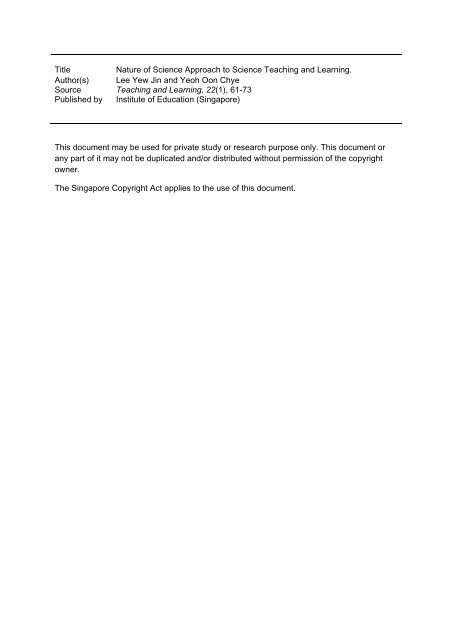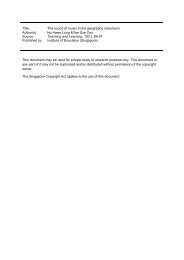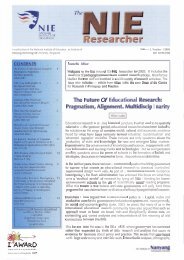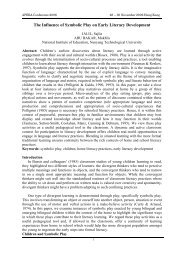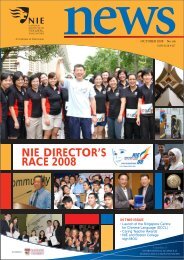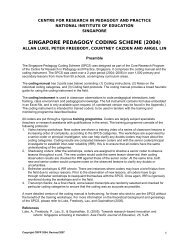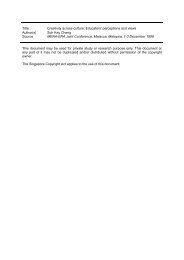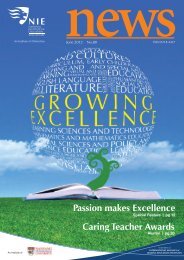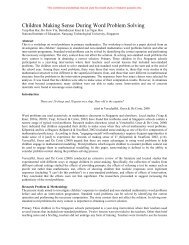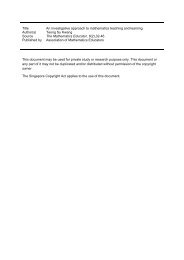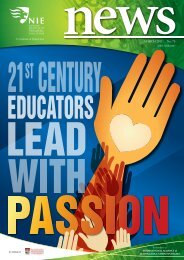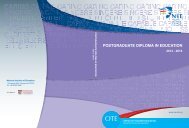Title Nature of Science Approach to Science Teaching and Learning ...
Title Nature of Science Approach to Science Teaching and Learning ...
Title Nature of Science Approach to Science Teaching and Learning ...
You also want an ePaper? Increase the reach of your titles
YUMPU automatically turns print PDFs into web optimized ePapers that Google loves.
<strong>Title</strong><strong>Nature</strong> <strong>of</strong> <strong>Science</strong> <strong>Approach</strong> <strong>to</strong> <strong>Science</strong> <strong>Teaching</strong> <strong>and</strong> <strong>Learning</strong>.Author(s) Lee Yew Jin <strong>and</strong> Yeoh Oon ChyeSource <strong>Teaching</strong> <strong>and</strong> <strong>Learning</strong>, 22(1), 61-73Published by Institute <strong>of</strong> Education (Singapore)This document may be used for private study or research purpose only. This document orany part <strong>of</strong> it may not be duplicated <strong>and</strong>/or distributed without permission <strong>of</strong> the copyrigh<strong>to</strong>wner.The Singapore Copyright Act applies <strong>to</strong> the use <strong>of</strong> this document.
ature <strong>of</strong> <strong>Science</strong> <strong>Approach</strong> <strong>to</strong> <strong>Science</strong><strong>Teaching</strong> <strong>and</strong> <strong>Learning</strong>Lee Yew Jin <strong>and</strong> Yeoh Oon ChyeMuch has been said in the local media about making a living in thenew economy. It has been perceived that one way <strong>of</strong> keeping acompetitive edge in the emerging knowledge-based global economywould be in the development <strong>of</strong> human potential - effected in the localeducational system by the Thinking Programme. This is not a newchallenge for Singapore as its leaders have long tried <strong>to</strong> promoteentrepreneurship <strong>and</strong> develop human talent <strong>to</strong> <strong>of</strong>fset a lack <strong>of</strong> l<strong>and</strong>, askilled workforce <strong>and</strong> financial capital (in the initial years <strong>of</strong> nationhoodat least). With the onset <strong>of</strong> the third millennium however, the stakesare even higher <strong>and</strong> more challenging. Hence the consistent emphasison the need <strong>to</strong> develop the human potential in Singapore.The Thinking Programme (TP) that has been introduced in theschools by the Ministry <strong>of</strong> Education aims <strong>to</strong> foster critical <strong>and</strong> creativethinking; <strong>to</strong> acknowledge <strong>and</strong> give due recognition that having the'facts' alone is insufficient, <strong>and</strong> that being able <strong>to</strong> evaluate the evidenceis crucial as well. It is an explicit aim <strong>of</strong> the curriculum now in place inSingapore schools <strong>to</strong> devote more time <strong>to</strong> appreciating contextual issuesin the subject matter. Pupils are encouraged <strong>to</strong> delve deeper, probe <strong>and</strong>ask hard questions in contrast <strong>to</strong> a previous situation whereby thecompletion <strong>of</strong> the prescribed syllabus was paramount <strong>and</strong> thus left littletime for such matters. Such teaching <strong>and</strong> learning environments c<strong>and</strong>o nothing but assist the growth <strong>of</strong> general literacy <strong>and</strong> democraticliving in a technologically-oriented society.Our policy makers have recognized that science plays, <strong>and</strong> willcontinue <strong>to</strong> play a critical role in the development <strong>of</strong> the economy <strong>of</strong>Singapore. The challenge is how best <strong>to</strong> develop the ability <strong>to</strong> bridgewhat students learn in school science with the needs <strong>of</strong> the market placefor the products <strong>of</strong> science (without neglecting the spirit <strong>and</strong> process<strong>of</strong> science). To do so, both teachers <strong>and</strong> students must acquire <strong>and</strong>develop a clear conception <strong>of</strong> what is science <strong>and</strong> its implications forscience teaching <strong>and</strong> learning.
<strong>Teaching</strong> & <strong>Learning</strong> 22: 1 July 2001+Described asOf instrumental worthGaining scientific or technicalknowledgePractical results, skills & factsFor the good <strong>of</strong> society first <strong>and</strong>then the individualMore short term goal'Knowing <strong>Science</strong>'+ Described asOf intrinsic worthThinking critically & creativelyabout natural worldScientific ways <strong>of</strong> knowingFor the good <strong>of</strong> the individualfirst <strong>and</strong> then societyMore long term goal'Knowing about <strong>Science</strong>'Figure 1. A model <strong>of</strong> <strong>Science</strong> <strong>and</strong> Scientific literacy based onMaienschein (1998).Figure 1 clarifies the active interplay between <strong>Science</strong> Literacy <strong>and</strong>Scientific Literacy. Clearly, there is a 'knowing' component (the facts,concepts, principles <strong>and</strong> structure) which is the predominant mode <strong>of</strong>science content knowledge encountered in schools <strong>and</strong> a 'knowingabout' science which is <strong>of</strong>ten only implicit in the intended curriculum.We feel that the TP is thus a timely correction <strong>to</strong>wards the nurturing <strong>of</strong>scientific literacy or 'knowing about science', though at no time doesthe curriculum neglect teaching <strong>and</strong> learning for science literacy or'knowing science' (see Maienschein, 1998). However, in the pursuit <strong>of</strong>scientific literacy, critical thinking is a necessary but not sufficientcondition, for its development. We maintain that what is advocated <strong>and</strong>taught in the local TP is both timely <strong>and</strong> desirable, particularly whenstudents learn <strong>to</strong> develop the logical, intellectual processing skills incritical <strong>and</strong> creative thinking. Yet, these by themselves do not necessarilyfocus on the process <strong>of</strong> knowledge construction or generation that islinked <strong>to</strong> the processes <strong>of</strong> concept learning <strong>and</strong> conceptual change(Yeoh, Lim & Jackson, 1998).
<strong>Nature</strong> <strong>of</strong> <strong>Science</strong> <strong>Approach</strong> <strong>to</strong> <strong>Science</strong> <strong>Teaching</strong> <strong>and</strong> <strong>Learning</strong>Boul<strong>to</strong>n <strong>and</strong> Panizzon (1998) have claimed that there are twoknowledge explosions in science education; one <strong>of</strong> facts (theoreticalknowledge) <strong>and</strong> the other <strong>of</strong> the practical processes <strong>of</strong> how scienceworks, <strong>and</strong> <strong>to</strong> be effective teachers need the ability <strong>to</strong> deal with both<strong>of</strong> them. Many science educa<strong>to</strong>rs now recognize that pupils should no<strong>to</strong>nly learn science (science literacy) but even more importantly, aboutscience [scientific literacy] (Matthews, 1998a). This body <strong>of</strong> knowledgehas been commonly described as the <strong>Nature</strong> <strong>of</strong> <strong>Science</strong> or NOS.Every discipline has its own ways <strong>of</strong> knowing <strong>and</strong> constructingreality, its syntactic structures, its philosophies <strong>and</strong> methods <strong>of</strong> inquiry.Even the process skills in <strong>Science</strong> (supposedly value free) are associatedwith a body <strong>of</strong> content knowledge, which is ultimately time <strong>and</strong> contextdependant. Lederman (1995) rightly reminds educa<strong>to</strong>rs that there is nota single conception <strong>of</strong> NOS but many, depending on the context <strong>of</strong> thatparticular community <strong>and</strong> what they value.The NOS refers <strong>to</strong> the 'epistemology <strong>of</strong> science, science as a way<strong>of</strong> knowing, or the values <strong>and</strong> beliefs inherent <strong>to</strong> the development <strong>of</strong>scientific knowledge' (Lederman, 1997: 1). This is the scientificenterprise which is at the heart <strong>of</strong> the NOS. It is an extremelycomplicated field as scientific knowledge arises from social, natural,political, cultural, his<strong>to</strong>rical <strong>and</strong> economic contingencies. A detailedanalysis <strong>of</strong> seven international science st<strong>and</strong>ards documents showedthat it revolved mainly round the philosophy, his<strong>to</strong>ry, sociology <strong>and</strong>psychology <strong>of</strong> science (McComas & Olson, 1998) which is graphicallyportrayed in Figure 2. For science educa<strong>to</strong>rs the phrase 'nature <strong>of</strong>science' is used <strong>to</strong> describe the intersection <strong>of</strong> issues addressed by thephilosophy, his<strong>to</strong>ry, sociology <strong>and</strong> psychology <strong>of</strong> science as they apply<strong>to</strong> <strong>and</strong> potentially impact science teaching <strong>and</strong> learning. As such, thisis a sound basis for guiding teachers <strong>to</strong> accurately portray science <strong>and</strong>its enterprise <strong>to</strong> the students.IMPORTANCEOF NOSWe neglect the explicit teaching (Lederman, 1998) <strong>of</strong> the NOS in ourscience curricula at our peril. To do so would be <strong>to</strong> devalue orundermine the rich <strong>and</strong> multi-textured underst<strong>and</strong>ing <strong>of</strong> science, inparticular how science functions in practice. Generally, a soundappreciation <strong>and</strong> working knowledge <strong>of</strong> NOS serves <strong>to</strong> enhance thelearning <strong>of</strong> science content, underst<strong>and</strong>ing <strong>of</strong> science, interest in science<strong>and</strong> informs the process <strong>of</strong> decision making. Tweney (1998: 153) believes
64 <strong>Teaching</strong> & <strong>Learning</strong> 22: I July 2001nPhilosophyHis<strong>to</strong>ry <strong>of</strong> <strong>Science</strong><strong>Science</strong>Sociology oP<strong>Science</strong><strong>of</strong>Figure 2. A graphic representation <strong>of</strong> the <strong>Nature</strong> <strong>of</strong> <strong>Science</strong> (McComas& Olson, 1998).The approximate extent <strong>to</strong> which each disciplinecontributes is represented by the relative sizes <strong>of</strong> the circles. Adescription <strong>of</strong> science - the nature <strong>of</strong> science - is found at theintersection <strong>of</strong> these various disciplines.that scientific cognition is special as it is the 'premier domain in whichculture, his<strong>to</strong>ry, <strong>and</strong> the social milieu intersect <strong>and</strong> lead us <strong>to</strong>ward newknowledge'. The pedagogical <strong>and</strong> theoretical basis <strong>of</strong> manyprogrammes in the United States that attempt <strong>to</strong> enhance thinking inschools adopt a cognitive-psychological approach which ignores thecontributions <strong>of</strong> philosophy, affective <strong>and</strong> social psychology. For thesereasons, Paul (1993) dismisses the credibility <strong>of</strong> such programmes <strong>to</strong>produce critical <strong>and</strong> rational thought in students. However, a sciencecurriculum that incorporates the NOS (in conjunction with the TP) willbe able <strong>to</strong> rectify these deficiencies <strong>and</strong> produce students who arescientifically literate. The challenge therefore, is for the science teachers<strong>to</strong> translate their underst<strong>and</strong>ing <strong>of</strong> the process <strong>of</strong> knowledgeconstruction in<strong>to</strong> meaningful <strong>and</strong> appropriate classroom discourse.NOS AND THE SCIENCE TEACHERThere have been numerous debates (see Eflin, Glennan & Reisch, 1999)as <strong>to</strong> what level <strong>of</strong> underst<strong>and</strong>ing should a teacher possess with regard<strong>to</strong> NOS. A pragmatic proposal has been suggested by Smith <strong>and</strong>Scharmann (1999) <strong>to</strong> concentrate on judging whether questions or fields<strong>of</strong> study are more or less scientific than others. In contrast, Matthews(1998b) advocates modest underst<strong>and</strong>ings <strong>of</strong> terms like law, theory,explanation, causes, hypothesis <strong>and</strong> observation in concurrence withGibbs <strong>and</strong> Lawson (1992). However, nearly all agree that aphilosopher's underst<strong>and</strong>ing <strong>of</strong> NOS is not necessary for students,teachers <strong>and</strong> even scientists.
<strong>Nature</strong> <strong>of</strong> <strong>Science</strong> <strong>Approach</strong> <strong>to</strong> <strong>Science</strong> <strong>Teaching</strong> <strong>and</strong> <strong>Learning</strong> 65Lederman (1998) proposed that the following underst<strong>and</strong>ings <strong>of</strong>NOS are elemental for our local high school science teachers. Theyought <strong>to</strong> comprehend that scientific knowledge:1. is tentative <strong>and</strong> is subject <strong>to</strong> change;2. is empirically based on <strong>and</strong>/or derived from observations <strong>of</strong> thenatural world;3. is subjective <strong>and</strong> thus theory-laden;4. necessarily involves human inference, imagination, <strong>and</strong> creativitythat lead <strong>to</strong> the invention <strong>of</strong> explanations;5. is socially <strong>and</strong> culturally embedded; <strong>and</strong>6. recognize the distinction between observations <strong>and</strong> inferences; <strong>and</strong>7. recognize the functions <strong>of</strong>, <strong>and</strong> relationships between scientifictheories <strong>and</strong> laws.BIOLOGICAL EVOLU-[ION : A CASE STUDY IN THE NOSBiological evolution is <strong>of</strong>ten a difficult <strong>and</strong> controversial <strong>to</strong>pic <strong>to</strong> teachin the high school syllabus. School children (e.g. Demastes, Good &Peebles, 1995), not <strong>to</strong> mention teachers (Lee, 1998) <strong>and</strong> the generalpublic (The Straits Times, 11 December 1997), have been shown <strong>to</strong> beunclear about many <strong>of</strong> the issues surrounding the theory <strong>of</strong> biologicalevolution. It would be simplistic <strong>to</strong> suggest that improvements in theirunderst<strong>and</strong>ing <strong>and</strong> acceptance <strong>of</strong> evolution could be resolved so readilyby just better teaching/learning (Smith, Siegal & McInerey, 1995) - inother words, better science literacy (knowing science). The pr<strong>of</strong>oundbiological ideas associated with evolution are many including genetics,ecology <strong>and</strong> physiology which by themselves are not only conceptuallydifficult but also <strong>of</strong>ten inter-linked. In view <strong>of</strong> the high level <strong>of</strong> cognitivedifficulty in the study <strong>of</strong> evolution, we wish <strong>to</strong> use this as a case study<strong>to</strong> illustrate some <strong>of</strong> the obstacles that exist in the teaching <strong>and</strong> learning<strong>of</strong> evolution. We suggest that many <strong>of</strong> the difficulties surrounding ascientific conception <strong>of</strong> biological evolution lie in the pedagogic neglect<strong>of</strong> scientific literacy because few educa<strong>to</strong>rs appreciate the meaningfulinsights that emerge from 'knowing about' evolution. These can besummed up as the two main obstacles in teaching <strong>and</strong> learning <strong>of</strong>evolution.Firstly, there is a near universally poor underst<strong>and</strong>ing <strong>of</strong> the NOS.Many researchers have pointed out that a poor underst<strong>and</strong>ing <strong>of</strong> theNOS in both teachers <strong>and</strong> pupils have lead <strong>to</strong> difficulties inunderst<strong>and</strong>ing biological evolution. One common problem is theinability <strong>to</strong> appreciate the differences between inference, fact, theories,laws <strong>and</strong> hypotheses. Only when science teachers have a working
66 <strong>Teaching</strong> & <strong>Learning</strong> 22: 1 July ZOO1knowledge <strong>of</strong> the NOS <strong>and</strong> the methods <strong>of</strong> science enquiry caneduca<strong>to</strong>rs in turn help learners separate half truths, emotional reactions,<strong>and</strong> dogmatic assertions from the century-old scientific endeavour inexplaining the theory <strong>of</strong> biological evolution. It is our view that mucheffort still remains in educating the biology educa<strong>to</strong>rs in Singapore withregard <strong>to</strong> the NOS.A second impediment <strong>to</strong> the meaningful underst<strong>and</strong>ing <strong>of</strong>evolution is due largely <strong>to</strong> conflicts with religious beliefs. In the pasttwo decades, the relationship between biology <strong>and</strong> religion has beenovershadowed by the creationist-evolution controversy, especially in theUnited States. Much <strong>of</strong> the antagonism between the hard-coreevolutionists <strong>and</strong> creationists (Fysh & Lucas, 1998) have shown a clearlack <strong>of</strong> appreciation <strong>of</strong> scientific facts <strong>and</strong> equally important, the NOS.It was also reported that in Malaysian schools, the teaching <strong>of</strong> sciencehas downplayed biological evolution, <strong>and</strong> is in essence a creationistscience (Loo, 1999).The phenomenon whereby a belief in the veracity <strong>of</strong> evolution isdivorced from an ability <strong>to</strong> reason <strong>and</strong> argue scientifically in this <strong>to</strong>pichas been documented by previous researchers working with pupils(Demastes, Settlage & Good, 1995), teachers (Lee, 1998; Lee & Yeoh,1998), university undergraduates <strong>and</strong> with academicians (Dagher &BouJaoude, 1997; Jackson, Doster, Meadows & Wood, 1995). Researchersare in agreement that underst<strong>and</strong>ing <strong>and</strong> acceptance in a potentiallycontroversial area like evolution depends more <strong>of</strong>ten on social, religious<strong>and</strong> metaphysical fac<strong>to</strong>rs rather than on conviction in the explana<strong>to</strong>rypowers <strong>of</strong> science. Indeed, the issue is complex. For example, Jacksonet al. (1995) have demonstrated that personal beliefs, especially amongststrongly religious people were resistant <strong>to</strong> change despite increase inknowledge <strong>of</strong> biological evolution. Of concern <strong>to</strong> science educa<strong>to</strong>rs,Roth <strong>and</strong> Alex<strong>and</strong>er (1997) have reported that religious commitmentsmay interfere with the learning <strong>of</strong> science especially in controversialareas such as abortion, euthanasia <strong>and</strong> about human origins.THE NOS APPROACHIn order <strong>to</strong> surmount the inherent obstacles for the effective teaching<strong>of</strong> scientific literacy, we propose two NOS strategies for science teaching<strong>and</strong> learning. One, there is the need <strong>to</strong> nurture among teachers theacceptance <strong>of</strong> the metaphysical <strong>and</strong> sociological processes underlyingthe scientific enterprise.No longer is the 'cold, hard <strong>and</strong> rational' conceptual change modelseen as adequate as a model <strong>of</strong> instruction in science, especially in an
<strong>Nature</strong> <strong>of</strong> <strong>Science</strong> <strong>Approach</strong> <strong>to</strong> <strong>Science</strong> <strong>Teaching</strong> <strong>and</strong> <strong>Learning</strong> 67area with a strong affective component such as biological evolution.Rudolph <strong>and</strong> Stewart (1998) have presented evidence that the neglect<strong>of</strong> metaphysical issues in science education have led <strong>to</strong> difficulties inunderst<strong>and</strong>ing science. In particular, they have suggested thategocentrism <strong>and</strong> anthropomorphism (attribution <strong>of</strong> human traits <strong>to</strong> nonhumanbeings) as his<strong>to</strong>rically persistent traits that should be consideredas part <strong>of</strong> the sense making processes that occur in classrooms. Theseresearchers have also argued that Lamarckian thinking, teleology <strong>and</strong>essentialism are rather 'natural' ways <strong>of</strong> explaining problems inevolutionary biology by pupils in schools <strong>and</strong> also by the scientists <strong>of</strong>the past. However, Zohar <strong>and</strong> Ginossar (1998) advocate what theyteasingly call a 'heretical suggestion'. They recommend that the taboo<strong>of</strong> teleology (advantageous outcomes are considered <strong>to</strong> explain naturalphenomenon) <strong>and</strong> anthropomorphism as a means <strong>of</strong> explaining inbiology should be removed as these are unresolved issues for educa<strong>to</strong>rs.Cunningham (1998: 484) has added that 'by describing the humanrelationships, beliefs <strong>and</strong> values that pervade science, sociologicalinsights challenge stereotypes' <strong>and</strong> thus sociology gives a realisticpicture <strong>of</strong> how science is practiced <strong>and</strong> constructed by society. We aremindful that the development <strong>of</strong> the theory <strong>of</strong> evolution is <strong>of</strong>tenpersuaded by the personal biases or prejudices <strong>of</strong> many scientists. Evennow one reads <strong>of</strong> academic feuds between two giants in evolutionarybiology - Stephen Gould <strong>and</strong> Richard Dawkins. Nonetheless, it mustbe emphasized that nearly all members <strong>of</strong> the scientific community arein agreement on the veracity <strong>of</strong> evolution. It is widely acknowledgedas the means for explaining both the diversity <strong>and</strong> unity <strong>of</strong> life sincethe beginning <strong>of</strong> time.Under these circumstances, there is the urgency <strong>to</strong> engage in theprocess <strong>of</strong> values clarification whereby one reveals these 'hidden'metaphysical issues during sensitive <strong>and</strong> informed teaching. Allviewpoints would have an equal chance <strong>of</strong> being heard <strong>and</strong> differencescan thus be discussed fruitfully, though not always resolved fully. Thereis a great urgency in having <strong>to</strong> listen <strong>to</strong> what learners bring <strong>to</strong> theevolution class, especially when faced with issues <strong>of</strong> creationism in thebiology lesson. For example, Dagher & BouJaoude, (1997) in Lebanon<strong>and</strong> Fysh & Lucas (1998) in Queensl<strong>and</strong> have tried <strong>to</strong> tackle these issuesin their classroom with participants who hold strong religious faiths.The science teacher who underst<strong>and</strong>s the sociological underpinningsin the science classroom can similarly <strong>of</strong>fer a more authentic <strong>and</strong>inclusive education. <strong>Science</strong>, after all, is still a human enterprise. Whilewe recognize that societal attitudes <strong>and</strong> beliefs can affect the corpus <strong>of</strong>science <strong>and</strong> its practices, at no time do we advocate any form <strong>of</strong>
68 <strong>Teaching</strong> & <strong>Learning</strong> 22: 1 July 2001relativism (Smith & Scharman, 1999; Sokal & Bricmont, 1998). Certain'truths', are just that; not some form <strong>of</strong> negotiated meanings amongscientists with deep vested interests <strong>to</strong> advance themselves.The second NOS strategy is <strong>to</strong> promote <strong>and</strong> <strong>to</strong> nurture the newimage <strong>of</strong> the NOS in biology. For a start, our new underst<strong>and</strong>ings <strong>of</strong>the NOS in the latter half <strong>of</strong> this century have firmly demolished theidea that scientific knowledge is always constructed in a rational, logical<strong>and</strong> even monolithic method. <strong>Science</strong>, as most philosophers <strong>of</strong> sciencenow underst<strong>and</strong> it <strong>to</strong> be, consists <strong>of</strong> multiple methods; some evenseemingly illogical <strong>and</strong> counter-intuitive in extreme cases. In otherwords, scientific progress which does not borrow from or is influencedby external societal fac<strong>to</strong>rs is just a myth. Ignorance <strong>of</strong> this dialecticalrelationship <strong>of</strong> science <strong>and</strong> society is unfortunately still held by manyeduca<strong>to</strong>rs <strong>and</strong> scientists alike.Consequently, most underst<strong>and</strong>ings <strong>of</strong> the NOS by educa<strong>to</strong>rs <strong>and</strong>scientists alike are premised on the physics model which places heavyemphasis on experimental laws, equations <strong>and</strong> models (Rudolph &Stewart, 1998). It was felt that this had placed biology underunnecessary dem<strong>and</strong>s <strong>to</strong> be equally rigorous in finding clear-cut,empirical evidence. Biology instead, <strong>of</strong>ten relies on a probabilistic rnodusoper<strong>and</strong>i, with extremely complex systems not easily amenable <strong>to</strong>physics-like experimentation. This is even more so with regard <strong>to</strong>biological evolution which is considered <strong>to</strong> be in the domain <strong>of</strong> thehis<strong>to</strong>rical sciences <strong>to</strong>gether with paleon<strong>to</strong>logy <strong>and</strong> bio-geography(Sober, 1993). For example, Darwin had amassed a huge amount <strong>of</strong>observational data <strong>to</strong> support his case for evolution although he didnot present any experimental results.Recently, the National Association <strong>of</strong> Biology Teachers in the UnitedStates issued a statement on the teaching <strong>of</strong> evolution which highlightedthat teachers may hold deep religious faith while still acceptingevolution as a valid scientific theory (McInerey, 1997). Besides suchassurances from secular organizations, many theologians <strong>of</strong> differentfaiths (e.g. Barbour, 1997; Haught, 1995) have proposed some extremelythoughtful models for the reconciliation between science <strong>and</strong> religion.They have basically sought dialogue <strong>and</strong> explored the higher realitiesthat exist between the two commonest means <strong>of</strong> Man's search forunderst<strong>and</strong>ing - Religion <strong>and</strong> <strong>Science</strong>. From the inquiry perspective,these are different realms <strong>of</strong> reality.
<strong>Nature</strong> <strong>of</strong> <strong>Science</strong> <strong>Approach</strong> <strong>to</strong> <strong>Science</strong> <strong>Teaching</strong> <strong>and</strong> <strong>Learning</strong> 69Operating within a strongly Islamic position, Haidar (1999) hasadvocated constructivism as being most compatible with religiousbeliefs <strong>and</strong> current underst<strong>and</strong>ing <strong>of</strong> NOS. Loo (1996: 285) asserts thatIslamic science in contrast <strong>to</strong> Western science, has much <strong>to</strong> <strong>of</strong>fer byhaving a 'more holistic human-centered approach that is grounded invalues that promote social justice, public welfare <strong>and</strong> responsibility<strong>to</strong>wards the environment'.A strong confrontational stance between religion <strong>and</strong> evolution isnot fruitful <strong>to</strong> either side <strong>and</strong> detrimental <strong>to</strong> progress in underst<strong>and</strong>ing.Even a live-<strong>and</strong>-let-live attitude characteristic <strong>of</strong> an 'independent'approach between the two sides was viewed as less satisfac<strong>to</strong>ry againstadopting an 'integration' or 'dialogue' approach. While discoveries inastrophysics <strong>and</strong> quantum mechanics have engendered much dialogue<strong>and</strong> integration between physicists <strong>and</strong> theologians, biologists generallyhave instead subscribed <strong>to</strong> the position <strong>of</strong> conflict or independencebetween religion <strong>and</strong> science. Exciting <strong>and</strong> novel ways <strong>of</strong> trying <strong>to</strong> relatescience <strong>and</strong> religion by showing their methodological parallels have alsobeen advanced by the British physicist turned clergyman JohnPolkinghorne <strong>and</strong> many others (e.g. Richardson & Wildman, 1996;Peacocke, 1993).Unless a dogmatic view <strong>of</strong> truth in religion is adopted, these newmodels <strong>of</strong> interaction between science <strong>and</strong> religion might help reconcile<strong>and</strong> challenge many <strong>of</strong> the difficulties people have with evolution. Itwill be a sad day indeed if every lesson in evolution for a teacher seems<strong>to</strong> repeat the legendary confrontation between Thomas Huxley(Darwin's 'Bulldog') <strong>and</strong> Bishop Wilberforce. And Barlow (1999) hasaptly commented that 'religions that do not embrace <strong>and</strong> give flesh <strong>to</strong>the s<strong>to</strong>ry <strong>to</strong>ld by science are missing a tremendous opportunity forrenewal <strong>and</strong> relevance'.Teachers need <strong>to</strong> be taught about the NOS during teacher education.We fear that if the Thinking Programme is incorporated, out <strong>of</strong> contextwith the NOS in science education, it would be teaching <strong>to</strong> know sciencebetter, not <strong>to</strong> know better about science. The local data about teachersunderst<strong>and</strong>ings <strong>of</strong> NOS (e.g. Lee, 1998) have shown that they haveinadequate knowledge about NOS. We therefore propose that the NOSbe emphasized increasingly in the science teacher education courses <strong>of</strong>study during the period <strong>of</strong> the Pre-<strong>and</strong> Inservice teacher training <strong>and</strong>training. This is already being done in the different pedagogicalmodules in the National Institute <strong>of</strong> Education. However, more needs
70 <strong>Teaching</strong> & <strong>Learning</strong> 22: 1 July 2001<strong>to</strong> be done in this area. A course in the university about the NOS mightnot be entirely adequate or appropriate because the content level maynot match the K-12 education system.In order <strong>to</strong> succeed as intended, we propose <strong>to</strong> incorporate aspects<strong>of</strong> the NOS in the formal school science curriculum. According <strong>to</strong> theCambridge GCE '0' level Biology (5090) syllabus, some <strong>of</strong> the NOSaims <strong>of</strong> syllabus are difficult <strong>to</strong> be translated in<strong>to</strong> testable objectives(University <strong>of</strong> Cambridge Local Examinations Syndicate, 1998). Thenewly revised Biology (5093) syllabus should be able <strong>to</strong> address theseissues. While not all NOS objectives can, or should be assessed, we agreewith Lederman (1998) that this, in effect leaves acquiring NOSknowledge as an afterthought, as belonging in the realm <strong>of</strong> affectivedevelopment. There needs <strong>to</strong> be explicit teaching <strong>of</strong> some aspects <strong>of</strong> theNOS in<strong>to</strong> the curriculum in order <strong>to</strong> develop <strong>and</strong> improve scientificliteracy.We propose that the local Thinking Programme should besymbiotically taught (carefully infused with <strong>and</strong> integrated) with theNOS objectives in mind in the science curriculum. Critical <strong>and</strong> creativethinking are certainly needed in appreciating NOS - while the his<strong>to</strong>ry<strong>of</strong> science provides numerous case studies whereby thinking skills areessential. We have provided a case study involving biological evolution<strong>to</strong> illustrate some <strong>of</strong> the possibilities <strong>of</strong> incorporating NOS in<strong>to</strong> ano<strong>to</strong>riously difficult <strong>to</strong>pic in science education <strong>to</strong> enhance its learning<strong>and</strong> acceptance. Our local curricula have also been sheltered from theextremes <strong>of</strong> faddish (or what some would call 'fashionable nonsense'[Sokal <strong>and</strong> Bricmont, 19981) assaults on traditional conceptions <strong>of</strong>science by Post-modernists, sociologists, Feminists, Marxists <strong>and</strong> othercritical theorists. How long this situation would remain under controlis uncertain. Be that as it may, shouldn't we aim for a public capable <strong>of</strong>discerning for themselves, the convoluted <strong>and</strong> multi-disciplinary issuesthat living in an increasingly technological society brings? Thus, it is<strong>of</strong> vital importance <strong>to</strong> start producing <strong>to</strong>day, scientifically literate pupils,armed with the facts <strong>of</strong> science, <strong>and</strong> with the wisdom <strong>to</strong> use it wisely.Mr Lee Yezu Jin is a staflon attachment <strong>to</strong> the National Institute <strong>of</strong> Educationfrom the Ministry <strong>of</strong> Education since 1999. His interests lie in the field <strong>of</strong>science education, specifically; in the philosophy <strong>of</strong> science, biological evolution,measurenzent <strong>and</strong> ethnographic approaches in science education.Dr Yeoh Oon Chye is presently the Direc<strong>to</strong>r <strong>of</strong> General Studies in the NanyangTechnological University. His focus is on instructional design, curriculumdevelopment <strong>and</strong> evaluation, biological science studies, concept learning <strong>and</strong>in managing the implementation <strong>of</strong> educational change.
<strong>Nature</strong> <strong>of</strong> <strong>Science</strong> <strong>Approach</strong> <strong>to</strong> <strong>Science</strong> <strong>Teaching</strong> <strong>and</strong> <strong>Learning</strong> 71Barbour, I. G. (1997). Religion In An Age Of <strong>Science</strong> : His<strong>to</strong>rical AndContemporary Issues. New York: Harper-Collins.Barlow, C. (1999). Evolution <strong>and</strong> the AAAS.(http:/ /www.sciences~irit.ore/FEATURES/91Barlowl.html)Boul<strong>to</strong>n, A., & Panizzon, D. (1998). The knowledge explosion in scienceeducation: balancing practical <strong>and</strong> theoretical knowledge. Journal<strong>of</strong> Research in <strong>Science</strong> <strong>Teaching</strong>, 35(5), 475481.Cunningham, C. M. (1998). Sociology <strong>of</strong> science as a means <strong>to</strong> a moreauthentic, inclusive science education. Journal <strong>of</strong> Research in <strong>Science</strong><strong>Teaching</strong>, 35(5), 483499.Dagher, Z. R., & BouJaoude, S. (1997). Scientific <strong>and</strong> religious beliefs <strong>of</strong>college students: The case <strong>of</strong> biological evolution. Journal <strong>of</strong> Researchin <strong>Science</strong> <strong>Teaching</strong>, 34(5), 429445.Demastes, S. S., Good, R.G., & Peebles, P. (1995). Students' conceptualecologies <strong>and</strong> the process <strong>of</strong> conceptual change in evolution. <strong>Science</strong>Education, 79(6), 637-666.Eflin, J. T., Glennan, S. & Reisch, G. (1999). The nature <strong>of</strong> science: Aperspective from the philosophy <strong>of</strong> science. Journal <strong>of</strong> Research in<strong>Science</strong> <strong>Teaching</strong>, 36(1), 107-116.Fysh, R. & Lucas, K. B. (1998). Religious beliefs in science classrooms.Research in <strong>Science</strong> Education, 28(4), 399-427.Gibbs, A. & Lawson, A. E. (1992). The nature <strong>of</strong> scientific thinking asreflected by the work <strong>of</strong> biologists & by biology textbooks. TheAmerican Biology Teacher, 54(3), 137-152.Haidar, A. H. (1999). Emirates pre-service <strong>and</strong> in-service teachers' viewsabout the nature <strong>of</strong> science. International Journal <strong>of</strong> <strong>Science</strong> Education,21(8), 807-22.Haught, J. F. (1995). <strong>Science</strong> <strong>and</strong> Religion: From Conflict <strong>to</strong> Conversation.New Jersey: Paulist Press.Jackson, D. F., Doster, E. C., Meadows, L. & Wood, T. (1995). Hearts <strong>and</strong>minds in the science classroom: the education <strong>of</strong> a confirmedevolutionist. Journal <strong>of</strong> Research in <strong>Science</strong> <strong>Teaching</strong>, 32(6), 585-611.Lederman, N. G. (1995). Suchting on the nature <strong>of</strong> scientific thought:Are we anchoring curricula in quicks<strong>and</strong>? <strong>Science</strong> <strong>and</strong> Education,4(4), 371-377.
72 <strong>Teaching</strong> & <strong>Learning</strong> 22: l July 200 1(1997). The nature <strong>of</strong> science: naturally? School <strong>Science</strong> <strong>and</strong>Mathematics, 97(1), 1-2.(1998). The state <strong>of</strong> science education: subject matter withoutcontext. Electronic Journal <strong>of</strong> <strong>Science</strong> Education [online]Available: http: / /unr.edu/home~ape/icannon/eise/lederman.html[V 3(2), 1998, December]Lee, Y. J. (1998). Comprehension <strong>of</strong> biological evolution by high school biologyteachers in Singapore. Unpublished Master <strong>of</strong> Education dissertation.Nanyang Technological University, Singapore.Lee, Y. J. & Yeoh, 0. C. (1998). <strong>Teaching</strong> biological evolution <strong>to</strong>Singapore's Teachers. Reports <strong>of</strong> the National Center for <strong>Science</strong>Education, 18(6), 6-9.Loo, S. P. (1996). The four horsemen <strong>of</strong> Islamic science: a critical analysis.International Journal <strong>of</strong> <strong>Science</strong> Education, 18, 285-294.(1999). Scientific underst<strong>and</strong>ing, control <strong>of</strong> the environment <strong>and</strong>science education, <strong>Science</strong> & Education, 8, 79-87.Maienschein, J. (1998). Scientific literacy. <strong>Science</strong>, 281, 917.Matthews. M. (1998a). How his<strong>to</strong>ry <strong>and</strong> philosophy in the US scienceeducation st<strong>and</strong>ards could have promoted multidisciplinaryteaching. School <strong>Science</strong> <strong>and</strong> Matl~ematics, 98(6), 285-293.(199813). In defense <strong>of</strong> modest goals when teaching about thenature <strong>of</strong> science. Jo~rrnal <strong>of</strong> Research in <strong>Science</strong> <strong>Teaching</strong>, 35(2),161-174.McComas, W. F., & Olson, J. K. (1998). The nature <strong>of</strong> science ininternational science education st<strong>and</strong>ards documents. In W. F.McComas (ed.), The <strong>Nature</strong> <strong>of</strong> <strong>Science</strong> in <strong>Science</strong> Education, pp. 41-52. Netherl<strong>and</strong>s : Kluwer Academic Press.McInerey, J. (1997). Evolution <strong>of</strong> the NABT statement on the teaching<strong>of</strong> evolution. Reports <strong>of</strong>the National Centerfor <strong>Science</strong> Education, 17(1),30-31.Paul, R. (1993). Philosophy <strong>and</strong> cognitive psychology: contrastingassumptions. In Richard W. Paul (ed.), Critical thinking: Wl~at EveryPerson Needs <strong>to</strong> Survive in a Rapidly Changing World, pp. 445454.California: Foundation for Critical Thinking.Richardson, W. M. & Wildman, W. J. (1996). Religion <strong>and</strong> <strong>Science</strong>. NewYork : Routledge.
<strong>Nature</strong> <strong>of</strong> <strong>Science</strong> <strong>Approach</strong> <strong>to</strong> <strong>Science</strong> <strong>Teaching</strong> <strong>and</strong> <strong>Learning</strong> 73Roth, W-M., & Alex<strong>and</strong>er, T. (1997). The interaction <strong>of</strong> students'scientific <strong>and</strong> religious discourses: two case studies. InternationalJournal <strong>of</strong> <strong>Science</strong> Education, 19(2), 125-146.Rudolph, J. L & Stewart, J. (1998). Evolution <strong>and</strong> the nature <strong>of</strong> science:On the his<strong>to</strong>rical discord <strong>and</strong> its implications for education. Journal<strong>of</strong> Research in <strong>Science</strong> <strong>Teaching</strong>, 35(10), 1069-1089.Smith, M. U. & Scharmann, L. C. (1999). Defining vs. describing thenature <strong>of</strong> science: A pragmatic analysis for classroom teachers <strong>and</strong>science educa<strong>to</strong>rs. <strong>Science</strong> Education, 84(3), 493-509.Smith, M. U., Siegel, H. & McInerney, J. D. (1995). Foundational issuesin evolution education. <strong>Science</strong> <strong>and</strong> Education, 4, 2346.Sober, E. (1993). Philosophy <strong>of</strong> Biology. Colorado: Westview Press.Sokal, A., & Bricmont, J. (1998). Fashionable Nonsense : PostmodernIntellectuals' Abuse <strong>of</strong> <strong>Science</strong>. New York: St. Martin's Press.The Straits Times (1997). 'Theory has been grossly misrepresented', 11December, 58.Tweney, R. D. (1998). Toward a cognitive psychology <strong>of</strong> science: recentresearch <strong>and</strong> its implications. Current Directions in Psychological<strong>Science</strong>, 7(5), 150-154.University <strong>of</strong> Cambridge Local Examinations Syndicate (1998). Biologyexamination syllabuses for 1999 (International examinations).Cambridge: Author.Yeoh, 0. C, Lim, T. K., & Jackson, T. (1998). Thinking frames : To linkthe thinker's <strong>to</strong>ol in philosophy for children <strong>to</strong> concept learning.In M. L. Quah <strong>and</strong> W. K. Ho (eds.), Thinking Processes: Going Beyondthe Surface Curriculum, pp. 58-74. Singapore: Prentice-Hall.Zohar, A., & Ginossar, S. (1998). Lifting the taboo regarding teleology<strong>and</strong> anthropomorphism in biology education - hereticalsuggestions. <strong>Science</strong> Education, 82, 679-697.


